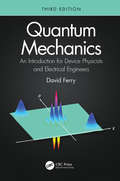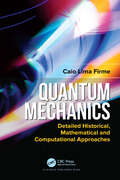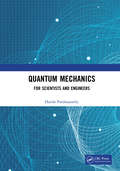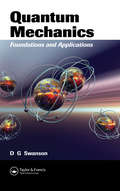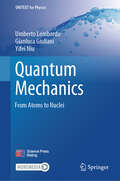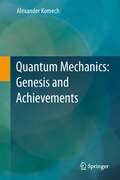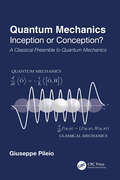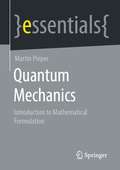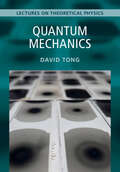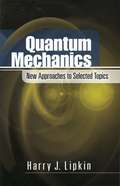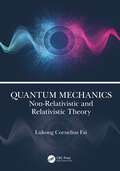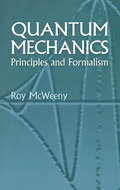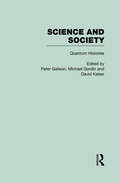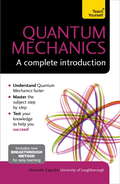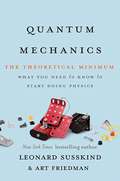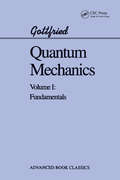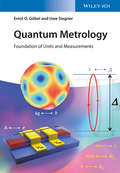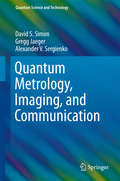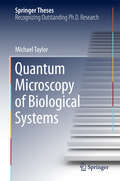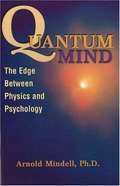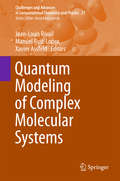- Table View
- List View
Quantum Mechanics: An Introduction for Device Physicists and Electrical Engineers
by David FerryQuantum Mechanics: An Introduction for Device Physicists and Electrical Engineers, Third Edition provides a complete course in quantum mechanics for students of semiconductor device physics and electrical engineering. It provides the necessary background to quantum theory for those starting work on micro- and nanoelectronic structures and is particularly useful for those beginning work with modern semiconductors devices, lasers, and qubits. This book was developed from a course the author has taught for many years with a style and order of presentation of material specifically designed for this audience. It introduces the main concepts of quantum mechanics which are important in everyday solid-state physics and electronics. Each topic includes examples which have been carefully chosen to draw upon relevant experimental research. It also includes problems with solutions to test understanding of theory. Full updated throughout, the third edition contains the latest developments, experiments, and device concepts, in addition to three fully revised chapters on operators and expectations and spin angular momentum, it contains completely new material on superconducting devices and approaches to quantum computing.
Quantum Mechanics: Detailed Historical, Mathematical and Computational Approaches
by Caio Lima FirmeMain features:i) A different approach for teaching Quantum Mechanics encompassing old quantum mechanics, matrix mechanics and wave mechanics in a historical perspective which helps to consolidate most important concepts of Quantum Mechanics;ii) Original information from the most important papers of Quantum Mechanics;iii) Derivation of all important equations of Quantum Mechanics, for example, Heisenberg’s uncertainty principle, de Broglie’s wave-particle duality, Schrödinger’s wave equation, etc., showing their interrelations through Dirac’s equations and other applications of matrix and wave mechanics;iv) Comprehensive mathematical support for the understanding of Quantum Mechanics; derivation of all equations make reading easier;v) The illustrations of the book cover examples, exercises and do-it-yourself activities;vi) Fundamentals of Fortran and numerical calculation along with the source codes for numerical solutions of several mathematical and quantum problems. All source codes are in the author’s site: (https://www.fortrancodes.com/);vii) Chapters devoted to linear algebra and differential equations applied to quantum mechanics and their numerical solutions;viii) Complete solution for the one-electron and two-electron problems using Schrödinger’s time independent equation along with their source codes.
Quantum Mechanics: For Scientists and Engineers
by Harish ParthasarathyThis book covers the entire span of quantum mechanics whose developments have taken place during the early part of the twentieth century up till the present day. We start with the Rutherford-Bohr model of the atom followed by Schrodinger's wave mechanics with its application to the solution of calculating the energy spectrum of a particle in a box, the harmonic oscillator and finally the hydrogen atom. Heisenberg's matrix mechanics and its duality with Schrodinger's wave mechanics, quantum mechanics in the interaction picture. Dirac's relativistic theory of the electron exhibiting the spin of the electron as a relativistic effect when it interacts with an external electromagnetic field. Feynman's path integral approach to non-relativistic quantum mechanics with is a marvellous intuitive interpretation as a sum over paths and how classical mechanics is obtained from its limit as Planck' constant tends to zero, methods for computing the spectra of the Dirac Hamiltonian in a radial potential, quantum field theory as developed by Feynman, Schwinger, Tomonaga and Dyson for describing the interaction between electrons, positrons, and photons via propagators using both the operator theoretic expansions and Feynman's path integral. We also introduce time independent and time dependent perturbation theory in quantum mechanics with applications to quantum gate design for quantum computers forming a major part of the research conducted by the author's research group, Quantum noise introduced into the Schrodinger and Dirac's equation based on the Hudson-Parthasarathy quantum stochastic calculus in Boson Fock space, scattering theory and wave operators with applications to quantum gate design, some aspects of second quantization like the interpretation of Boson Fock space in terms of harmonic oscillator algebras and the BCS theory of superconductivity, Wigner-Mackey-Frobenius theory of induced representations of a group with applications to Wigner's theory of particle classification, Dirac's equation in a gravitational field and Yang-Mills non-Abelian gauge theories with application to the construction of unified quantum field theories and finally, the more recent theory of super-symmetry which is a Boson-Fermion unification theory. We have discussed the statistics of Boson's, Fermions and Maxwell-Boltzmann based on entropy maximization. The book is written in problem-solution format and it would be of use to physicists and engineers interested respectively in developing unified field theories and in the design of quantum gates. Note: T&F does not sell or distribute the Hardback in India, Pakistan, Nepal, Bhutan, Bangladesh and Sri Lanka.
Quantum Mechanics: Foundations and Applications
by Donald Gary SwansonProgressing from the fundamentals of quantum mechanics (QM) to more complicated topics, Quantum Mechanics: Foundations and Applications provides advanced undergraduate and graduate students with a comprehensive examination of many applications that pertain to modern physics and engineering.Based on courses taught by the author, this textboo
Quantum Mechanics: From Atoms to Nuclei (UNITEXT for Physics)
by Umberto Lombardo Gianluca Giuliani Yifei NiuThis book is intended to provide a self-contained introduction to the principles of Quantum Mechanics, based on the analysis of measurement processes of microscopic systems and the introduction of the physical observables as generators of symmetry transformations. After standard training arguments the applications are mainly focused on atomic and nuclear phenomena, as they occur on a quite different space-time scale. Thus, the text flows from the simplest systems, i.e. proton-electron in the hydrogen atom and proton-neutron in the Deuteron nucleus, to the complex many- body systems, i.e. stable states of atoms and nuclei of the periodic table, and finally to infinite many-body systems, including atomic and nuclear fluids. A digression is made on the application to astrophysical compact systems. The textbook is suitable for upper undergraduate students and graduate students in physics and related majors. Additional questions and answers via app: Download the Springer Nature Flashcards app free of charge and use exclusive additional material to test your knowledge.
Quantum Mechanics: Genesis and Achievements
by Alexander KomechThe focus of the present work is nonrelativistic and relativistic quantum mechanics with standard applications to the hydrogen atom. The author has aimed at presenting quantum mechanics in a comprehensive yet accessible for mathematicians and other non-physicists. The genesis of quantum mechanics, its applications to basic quantum phenomena, and detailed explanations of the corresponding mathematical methods are presented. The exposition is formalized (whenever possible) on the basis of the coupled Schroedinger, Dirac and Maxwell equations. Aimed at upper graduate and graduate students in mathematical and physical science studies.
Quantum Mechanics: Inception or Conception? A Classical Preamble to Quantum Mechanics
by Giuseppe PileioEmbarking on a journey into the realm of quantum mechanics can be a daunting task for anyone. Its puzzling mathematics and bewildering predictions often leave individuals feeling confused and disheartened. But what if there was a different approach — one aimed to cultivate an understanding of quantum mechanics from its very foundations? This is the ambition of this book. Rather than treating quantum mechanics as an inception, the author takes a Socratic perspective, tracing the genesis of its key ideas back to the well-established roots of classical mechanics. The works of Lagrange, Hamilton, and Poisson become guiding lights, illuminating the path towards comprehension. Through a colloquial yet pedagogical narrative, the book delves into the elements of classical mechanics, building a solid framework of familiarity that paves the way for comprehending quantum mechanics.Designed as a companion for undergraduates undertaking quantum mechanics modules in physics or chemistry, this book serves as an invaluable support. It equips learners with the essential knowledge necessary to grasp the foundations of quantum mechanics. As such, it proves equally beneficial for MSc and PhD scholars, and post-doctoral researchers. Its colloquial tone captivates the curiosity of any reader eager to delve into the mysteries of this enthralling field.
Quantum Mechanics: Introduction to Mathematical Formulation (essentials)
by Martin PieperAnyone who has always wanted to understand the hieroglyphs on Sheldon's blackboard in the television series The Big Bang Theory or who wanted to know exactly what the fate of Schrödinger's cat is all about will find a short, descriptive introduction to the world of quantum mechanics in this essential . In particular, the text focuses on the mathematical description in the Hilbert space. The content goes beyond popular scientific presentations, but is nevertheless suitable for readers without special prior knowledge thanks to the clear examples. This Springer essential is a translation of the original German 1st edition essentials, Quantenmechanik by Martin Pieper published by Springer Fachmedien Wiesbaden GmbH, part of Springer Nature in 2019.The translation was done with the help of artificial intelligence (machine translation by the service DeepL.com). A subsequent human revision was done primarily in terms of content, so that the book will read stylistically differently from a conventional translation. Springer Nature works continuously to further the development of tools for the production of books and on the related technologies to support the authors.The author:Prof. Dr. Martin Pieper has been Professor of Mathematics and Simulation at the FH Aachen since 2011. Before he was appointed to the FH Aachen, he was a research assistant in the Optimization department of the Fraunhofer Institute for Industrial Mathematics.
Quantum Mechanics: Lectures on Theoretical Physics
by David TongThe universe we live in is both strange and interesting. This strangeness comes about because, at the most fundamental level, the universe is governed by the laws of quantum mechanics. This is the most spectacularly accurate and powerful theory ever devised, one that has given us insights into many aspects of the world, from the structure of matter to the meaning of information. This textbook provides a comprehensive account of all things quantum. It starts by introducing the wavefunction and its interpretation as an ephemeral wave of complex probability, before delving into the mathematical formalism of quantum mechanics and exploring its diverse applications, from atomic physics and scattering, to quantum computing. Designed to be accessible, this volume is suitable for both students and researchers, beginning with the basics before progressing to more advanced topics.
Quantum Mechanics: New Approaches to Selected Topics
by Harry J. LipkinAcclaimed as "excellent" (Nature) and "very original and refreshing" (Physics Today), this collection of self-contained studies is geared toward advanced undergraduates and graduate students. Its broad selection of topics includes the Mössbauer effect, many-body quantum mechanics, scattering theory, Feynman diagrams, and relativistic quantum mechanics.Author Harry J. Lipkin, a well-known teacher at Israel's Weizmann Institute, takes an unusual approach by introducing many interesting physical problems and mathematical techniques at a much earlier point than in conventional texts. This method enables students to observe the physical implications and useful applications of quantum theory before mastering the formalism in detail, and it provides them with new mathematical tools at an earlier stage for use in subsequent problems.
Quantum Mechanics: Non-Relativistic and Relativistic Theory
by Lukong Cornelius FaiThis book presents an accessible treatment of non-relativistic and relativistic quantum mechanics. It is an ideal textbook for undergraduate and graduate physics students, and is also useful to researchers in theoretical physics, quantum mechanics, condensed matter, mathematical physics, quantum chemistry, and electronics. This student-friendly and self-contained textbook covers the typical topics in a core undergraduate program, as well as more advanced, graduate-level topics with an elegant mathematical rigor, contemporary style, and rejuvenated approach. It balances theory and worked examples, which reinforces readers' understanding of fundamental concepts. The analytical methods employed in this book describe physical situations with mathematical rigor and in-depth clarity, emphasizing the essential understanding of the subject matter without need for prior knowledge of classical mechanics, electromagnetic theory, atomic structure, or differential equations. Key Features: • Remains accessible but incorporates a rigorous, updated mathematical treatment• Laid out in a student-friendly structure• Balances theory with its application through examples Lukong Cornelius Fai is a professor of theoretical physics at the Department of Physics, Faculty of Sciences, University of Dschang, Cameroon. He is Head of Condensed Matter and Nanomaterials as well as the Mesoscopic and Multilayer Structures Laboratory. He was formerly a senior associate at the Abdus Salam International Centre for Theoretical Physics (ICTP), Italy. He holds a Master of Science in Physics and Mathematics (1991) as well as a Doctor of Science in Physics and Mathematics (1997) from Moldova State University. He is the author of over 170 scientific publications and five textbooks.
Quantum Mechanics: Principles and Formalism
by Roy McweenyConcerned strictly with the principles and formalism of quantum mechanics, this graduate student-oriented volume develops the subject as a fundamental discipline. Opening chapters review the origins of Schrödinger's equations and the nature of the solutions in certain simple and well-known cases, advancing to the ideas associated with vector spaces. Having provided students with the appropriate mathematical language, the author proceeds to the formulation of the main principles of quantum mechanics and their immediate consequences. The book concludes with final generalizations in which alternative "languages" or representations are discussed -- each with reference to its specific advantages and applications -- and the Dirac transformation theory is developed and explained.
Quantum Mechanics: Science and Society
by Peter Galison David Kaiser Michael GordinModern science has changed every aspect of life in ways that cannot be compared to developments of previous eras. This four-volume set presents key developments within modern physical science and the effects of these discoveries on modern global life. The first two volumes explore the history of the concept of relativity, the cultural roots of science, the concept of time and gravity before, during, and after Einstein's theory, and the cultural reception of relativity. Volume 3 explores the impact of modern science upon global politics and the creation of a new kind of war, and Volume 4 details the old and new efforts surrounding the elucidation of the quantum world, as well as the cultural impact of particle physics. This reprint collection pools the best scholarship available, collected from a large array of difficult to acquire books, journals, and pamphlets. Each volume begins with an introductory essay, written by one of the top scholars in the history of science. Students and scholars of modern culture, science, and society will find these volumes a veritable research gold mine.
Quantum Mechanics: Teach Yourself
by Alexandre ZagoskinWritten by Dr Alexandre Zagoskin, who is a Reader at Loughborough University, Quantum Mechanics: A Complete Introduction is designed to give you everything you need to succeed, all in one place. It covers the key areas that students are expected to be confident in, outlining the basics in clear jargon-free English, and then providing added-value features like summaries of key ideas, and even lists of questions you might be asked in your exam. The book uses a structure that is designed to make quantum physics as accessible as possible - by starting with its similarities to Newtonian physics, rather than the rather startling differences.
Quantum Mechanics: The Theoretical Minimum (The Theoretical Minimum)
by Leonard Susskind Art FriedmanFrom the bestselling author of The Theoretical Minimum, an accessible introduction to the math and science of quantum mechanicsQuantum Mechanics is a (second) book for anyone who wants to learn how to think like a physicist. In this follow-up to the bestselling The Theoretical Minimum, physicist Leonard Susskind and data engineer Art Friedman offer a first course in the theory and associated mathematics of the strange world of quantum mechanics. Quantum Mechanics presents Susskind and Friedman's crystal-clear explanations of the principles of quantum states, uncertainty and time dependence, entanglement, and particle and wave states, among other topics. An accessible but rigorous introduction to a famously difficult topic, Quantum Mechanics provides a tool kit for amateur scientists to learn physics at their own pace.
Quantum Mechanics: Volume 1: Fundamentals (Graduate Texts In Contemporary Physics Series)
by Kurt GottfriedThis book contains discussions of radiation theory, quantum statistics and the many-body problem, and more advanced topics in collision theory. It is intended as a text for a first-year graduate quantum mechanics course.
Quantum Metrology
by Uwe Siegner Ernst O. GoebelThe International System of Units (SI) is the world's most widely used system of measurement, used every day in commerce and science, and is the modern form of the metric system. It currently comprises the meter (m), the kilogram (kg), the second (s), the ampere (A), the kelvin (K), the candela (cd) and the mole (mol)). The system is changing though, units and unit definitions are modified through international agreements as the technology of measurement progresses, and as the precision of measurements improves. The SI is now being redefined based on constants of nature and their realization by quantum standards. Therefore, the underlying physics and technologies will receive increasing interest, and not only in the metrology community but in all fields of science. This book introduces and explains the applications of modern physics concepts to metrology, the science and the applications of measurements. A special focus is made on the use of quantum standards for the realization of the forthcoming new SI (the international system of units). The basic physical phenomena are introduced on a level which provides comprehensive information for the experienced reader but also provides a guide for a more intense study of these phenomena for students.
Quantum Metrology, Imaging, and Communication
by Gregg Jaeger David S. Simon Alexander V. SergienkoThis book describes the experimental and theoretical bases for the development of specifically quantum-mechanical approaches to metrology, imaging, and communication. In particular, it presents novel techniques developed over the last two decades and explicates them both theoretically and by reference to experiments which demonstrate their principles in practice. The particular techniques explored include two-photon interferometry, two-photon optical aberration and dispersion cancellation, lithography, microscopy, and cryptography.
Quantum Microscopy of Biological Systems
by Michael TaylorThis thesis reports on the development of the first quantum enhanced microscope and on its applications in biological microscopy. The first quantum particle-tracking microscope, described in detail here, represents a pioneering advance in quantum microscopy, which is shown to be a powerful and relevant technique for future applications in science and medicine. The microscope is used to perform the first quantum-enhanced biological measurements -- a central and long-standing goal in the field of quantum measurement. Sub diffraction-limited quantum imaging is achieved, also for the first time, with a scanning probe imaging configuration allowing 10-nanometer resolution.
Quantum Mind: The Edge Between Physics and Psychology
by Arnold MindellBy exploring principles found in psychology, math, physics, and shamanism, it becomes possible to link a cosmic perspective with ordinary life.
Quantum Modeling of Complex Molecular Systems
by Jean-Louis Rivail Manuel Ruiz-Lopez Xavier AssfeldThis multi-author contributed volume includes methodological advances and original applications to actual chemical or biochemical phenomena which were not possible before the increased sophistication of modern computers. The chapters contain detailed reviews of the developments of various computational techniques, used to study complex molecular systems such as molecular liquids and solutions (particularly aqueous solutions), liquid-gas, solid-gas interphase and biomacromolecular systems. Quantum modeling of complex molecular systems is a useful resource for graduate students and fledgling researchers and is also an excellent companion for research professionals engaged in computational chemistry, material science, nanotechnology, physics, drug design, and molecular biochemistry.
Quantum Models of Cognition and Decision
by Jerome R. Busemeyer Peter D. BruzaMuch of our understanding of human thinking is based on probabilistic models. This innovative book by Jerome R. Busemeyer and Peter D. Bruza argues that, actually, the underlying mathematical structures from quantum theory provide a much better account of human thinking than traditional models. They introduce the foundations for modelling probabilistic-dynamic systems using two aspects of quantum theory. The first, 'contextuality', is a way to understand interference effects found with inferences and decisions under conditions of uncertainty. The second, 'quantum entanglement', allows cognitive phenomena to be modeled in non-reductionist ways. Employing these principles drawn from quantum theory allows us to view human cognition and decision in a totally new light. Introducing the basic principles in an easy-to-follow way, this book does not assume a physics background or a quantum brain and comes complete with a tutorial and fully worked-out applications in important areas of cognition and decision.
Quantum Monte Carlo Approaches For Correlated Systems
by Federico Becca Sandro SorellaOver the past several decades, computational approaches to studying strongly-interacting systems have become increasingly varied and sophisticated. This book provides a comprehensive introduction to state-of-the-art quantum Monte Carlo techniques relevant for applications in correlated systems. Providing a clear overview of variational wave functions, and featuring a detailed presentation of stochastic samplings including Markov chains and Langevin dynamics, which are developed into a discussion of Monte Carlo methods. The variational technique is described, from foundations to a detailed description of its algorithms. Further topics discussed include optimisation techniques, real-time dynamics and projection methods, including Green's function, reptation and auxiliary-field Monte Carlo, from basic definitions to advanced algorithms for efficient codes, and the book concludes with recent developments on the continuum space. Quantum Monte Carlo Approaches for Correlated Systems provides an extensive reference for students and researchers working in condensed matter theory or those interested in advanced numerical methods for electronic simulation.
Quantum Monte-Carlo Programming: For Atoms, Molecules, Clusters, and Solids
by Wolfgang Schattke Ricardo Díez MuiñoQuantum Monte Carlo is a large class of computer algorithms that simulate quantum systems to solve many body systems in order to investigate the electronic structure of many-body systems. <P><P>This book presents a numeric approach to determine the electronic structure of atoms, molecules and solids. Because of the simplicity of its theoretical concept, the authors focus on the variational Quantum-Monte-Carlo (VQMC) scheme. The reader is enabled to proceed from simple examples as the hydrogen atom to advanced ones as the Lithium solid. Several intermediate steps cover the Hydrogen molecule, how to deal with a two electron systems, going over to three electrons, and expanding to an arbitrary number of electrons to finally treat the three-dimensional periodic array of Lithium atoms in a crystal. The exmples in the field of VQMC are followed by the subject of diffusion Monte-Calro (DMC) which covers a common example, the harmonic ascillator. The book is unique as it provides both theory and numerical programs. It includes rather practical advices to do what is usually described in a theoretical textbook, and presents in more detail the physical understanding of what the manual of a code usually promises as result. Detailed derivations can be found at the appendix, and the references are chosen with respect to their use for specifying details or getting an deeper understanding .The authors address an introductory readership in condensed matter physics, computational phyiscs, chemistry and materials science. As the text is intended to open the reader's view towards various possibilities of choices of computing schemes connected with the method of QMC, it might also become a welcome literature for researchers who would like to know more about QMC methods. The book is accompanied with a collection of programs, routines, and data.
Quantum Nano-Plasmonics
by Witold A. JacakWith examples and clear explanation throughout, this step-by-step approach makes quantum theory of plasmons accessible to readers without specialized training in theory. Jacak uses original research results to offer a fully analytical theory formulation suitable for further development and applications. The theory is focused on the Random Phase Approximation description of plasmons in metallic nano-structures, previously defined for bulk metal. Particular attention is paid to large damping of plasmons in nanostructures including electron scattering and Lorentz friction losses, quantum description of plasmon photovoltaic effect is presented and there is in-depth analysis of plasmon-polariton kinetics in metallic nano-chains. Suitable for students in the field of plasmonics, opto-electronics and photonics, and for researchers active in the field of photo-voltaics, opto-electronics, nano-plasmonics and nano-photonics. Also of help to researchers in soft plasmonics with applications to electro-signalling in neurons.
